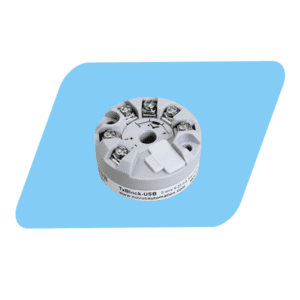 It seems like at least once a week we get a customer asking, “how long of a wire can I run between my thermocouple and the data logger?” and our standard answer is, “it depends!” There are several important points to understand when answering this question:
It seems like at least once a week we get a customer asking, “how long of a wire can I run between my thermocouple and the data logger?” and our standard answer is, “it depends!” There are several important points to understand when answering this question:
- First, a thermocouple measures temperature by generating a very small voltage based on the temperature where the 2 wires are fused together at the tip or junction. For example, at a room temperature of 72°F, a type K thermocouple will output .000888 volts.
- Second, the operation of the thermocouple is based on the Seebeck effect, where a conductor will generate a voltage differential across two points when there is a temperature difference between these points. This voltage is very dependent on the composition of the conductor; variations in the material will cause changes in the voltage vs. temperature characteristic.
These factors, when combined with the environment where the thermocouple will be used, directly affect the practical length of a run of thermocouple wire.
Is There Any Interference Nearby?
Probably the most important thing to consider is the effect of electrical and magnetic interference (EMI) in the environment when combined with the small output voltage of the thermocouple. One of the worst cases we ever ran into was a customer at a not-to-be-named nuclear power plant. He purchased one of our loggers to monitor the temperature inside a reactor room. After hooking up the thermocouples, he called us to say that the measurements were terrible. We were quite surprised because we had used these loggers in dozens of other applications with no problems. We dug a bit deeper and found out that the thermocouple wires were over a hundred feet long. Normally, this would not directly cause a problem, but that in this case, the wires were running in conduit through the concrete wall of the reactor building alongside control and power cables. The thermocouple wires were picking up all sorts of electrical noise from the signals in these other cables, which was completely swamping out the signal for proper measurements.
So, when determining how far you can run the wires, it is essential to look at the area they will be going through and see if there are significant sources of electrical interference nearby. If so, you will have to keep the runs short or use twisted pair, shielded thermocouple wires, making sure that the shield is connected to good earth ground at only one end.
What Material Is Your Wire Made Of?
It’s also important to consider potential voltage drops across the length of the wire. Thermocouple wire is typically in the range of 18 to 24 gauge. For 24 gauge K-type wire, the resistance is about 1.5 ohms per foot for the pair. A 200-foot run would have a resistance of about 300 ohms, and when used with a typical data logger, this resistance could cause an error of nearly 0.5%. If you anticipate having to use a long run, consider using a larger diameter wire like 18 or 16 gauge to minimize resistance and voltage drop.
As noted above, the voltage created by a thermocouple is dependent on the temperature difference between the two ends of the wire and the material the wire is made of. The wire manufacturers do their best to maintain a consistent alloy throughout the wire, but even small variations in the alloy composition can have a big effect on the output voltage vs. temperature characteristic. Using very long runs increases the possibility of introducing material variations across the length of the wire. If you want to use a long length of wire, consider using wire with improved accuracy specifications, sometimes called “Special Limits of Error” or “SLE.” The extra cost may justify the improvement in measurement accuracy when making a long run.
Wrapping It All Up
So, what does this all really mean? Practically speaking, the longest you want to go with a standard thermocouple run is about 100 feet without having to start jumping through hoops to get an accurate, low noise measurement. Even in this case, you will probably want to use shielded, SLE wire at least 18 gauge or larger. Just to be safe, we normally recommend a maximum of about 50 feet using regular thermocouples.
Now you may be saying to yourself, “OK, I still need to run 150 feet and I don’t want to go through all of this.” Well, the answer is actually pretty simple. We, along with many other vendors, offer thermocouple signal conditioners, such as the Novus TxBlock. These signal conditioners take the low-level millivolt output of the thermocouple and convert it to a high-level signal, like a 4-20 milliamp current that is much more suitable to run long distances. Using a signal conditioner like this has multiple benefits:
- A high-level signal like a 4-20 mA current loop will be much more immune to the effects of EMI.
- The effect of cable resistance will be eliminated as long as the power supply can drive the loop.
- You can use lower-cost standard 2 conductor wire for the amplified signal instead of the more expensive shielded thermocouple wire.
As a comparison, 20 gauge, twisted pair, shielded K type thermocouple wire is about $1.41 per foot for a 500-foot roll while 2 conductor cable is $.14 per foot in the same size spool. The signal conditioner cost is a little over $50, so for anything over 45 feet, you will be ahead cost-wise using the regular wire and the TxBlock. Not to mention, you will have more accurate and lower noise measurements!


Leave a Reply
You must be logged in to post a comment.